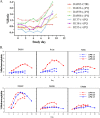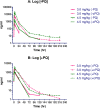Pharmacokinetics and pharmacodynamics of (+)-primaquine and (-)-primaquine enantiomers in rhesus macaques (Macaca mulatta)
- PMID: 25267666
- PMCID: PMC4249570
- DOI: 10.1128/AAC.02576-13
Pharmacokinetics and pharmacodynamics of (+)-primaquine and (-)-primaquine enantiomers in rhesus macaques (Macaca mulatta)
Abstract
Primaquine (PQ) remains the sole available drug to prevent relapse of Plasmodium vivax malaria more than 60 years after licensure. While this drug was administered as a racemic mixture, prior studies suggested a pharmacodynamic advantage based on differential antirelapse activity and/or toxicities of its enantiomers. Oral primaquine enantiomers prepared using a novel, easily scalable method were given for 7 days to healthy rhesus macaques in a dose-rising fashion to evaluate their effects on the blood, liver, and kidneys. The enantiomers were then administered to Plasmodium cynomolgi-infected rhesus macaques at doses of 1.3 and 0.6 mg/kg of body weight/day in combination with chloroquine. The (-)-PQ enantiomer had higher clearance and apparent volume of distribution than did (+)-PQ and was more extensively converted to the carboxy metabolite. There is evidence for differential oxidative stress with a concentration-dependent rise in methemoglobin (MetHgb) with increasing doses of (+)-PQ greater than that seen for (-)-PQ. There was a marked, reversible hepatotoxicity in 2 of 3 animals dosed with (-)-PQ at 4.5 mg/kg. (-)-PQ in combination with chloroquine was successful in preventing P. cynomolgi disease relapse at doses of 0.6 and 1.3 mg/kg/day, while 1 of 2 animals receiving (+)-PQ at 0.6 mg/kg/day relapsed. While (-)-PQ was also associated with hepatotoxicity at higher doses as seen previously, this has not been identified as a clinical concern in humans during >60 years of use. Limited evidence for increased MetHgb generation with the (+) form in the rhesus macaque model suggests that it may be possible to improve the therapeutic window for hematologic toxicity in the clinic by separating primaquine into its enantiomers.
Copyright © 2014, American Society for Microbiology. All Rights Reserved.
Figures




References
-
- Brewer GJ, Tarlov AR, Kellermeyer RW, Alving AS. 1962. The hemolytic effect of primaquine. XV. Role of methemoglobin. J. Lab. Clin. Med. 59:905–917. - PubMed
-
- Myint HY, Berman J, Walker L, Pybus B, Melendez V, Baird JK, Ohrt C. 2011. Improving the therapeutic index of 8-aminoquinolines by the use of drug combinations: review of the literature and proposal for future investigations. Am. J. Trop. Med. Hyg. 85:1010–1014. 10.4269/ajtmh.2011.11-0498. - DOI - PMC - PubMed
-
- Beutler E. 1959. The hemolytic effect of primaquine and related compounds: a review. Blood 14:103–139. - PubMed
-
- Nanayakkara NP, Ager AL, Jr, Bartlett MS, Yardley V, Croft SL, Khan IA, McChesney JD, Walker LA. 2008. Antiparasitic activities and toxicities of individual enantiomers of the 8-aminoquinoline 8-[(4-amino-1-methylbutyl)amino]-6-methoxy-4-methyl-5-[3,4-dichlorophenoxy]quinoline succinate. Antimicrob. Agents Chemother. 52:2130–2137. 10.1128/AAC.00645-07. - DOI - PMC - PubMed
MeSH terms
Substances
LinkOut - more resources
Full Text Sources
Other Literature Sources
Medical

